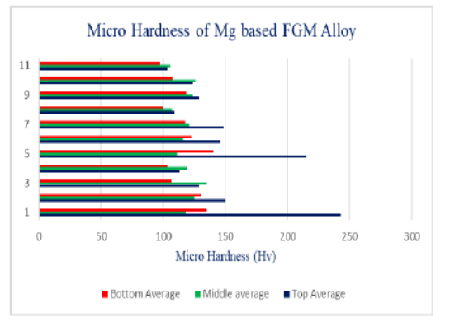


Indian Journal of Science and Technology
DOI: 10.17485/IJST/v17i15.3144
Year: 2024, Volume: 17, Issue: 15, Pages: 1557-1565
Original Article
M Anil Kumar1*, V Srinivasan2, P Ramamurthy Raju3
1Research Scholar, Department of Manufacturing Engineering, Faculty of Engineering and Technology, Annamalai University, Annamalai Nagar, 608 002, Tamil Nadu, India
2Associate Professor, Department of Manufacturing Engineering, Faculty of Engineering and Technology, Annamalai University, Annamalai Nagar, 608 002, Tamil Nadu, India
3Professor, SRKR Engineering College, Bhimavaram, Andhra Pradesh, India
*Corresponding Author
Email: [email protected]
Received Date:13 December 2023, Accepted Date:23 February 2024, Published Date:12 April 2024
Objectives: The aim of this study is to examine the tribological properties and microstructural of functionally graded material (FGM) composites based on magnesium (Mg) base material. Magnesium alloys are commonly employed in the development of biomaterials for implant applications owing to their favorable corrosion properties. The research objective is to produce Zn/Mo reinforced functionally graded magnesium composites using the centrifugal casting. Methods: A centrifugal process was employed to fabricate a functionally graded material (FGM) consisting of three layers with a cylindrical shape. The base material used for this FGM was Magnesium, which was alloyed with 10% of Zn and 10% of Mo. The developed FGMs have been analyzed for their mechanical and microstructural characteristics. The microstructure of the samples were analyzed via the Optical Microscope (OM). It is identified that denser particle molybdenum (Mo) have influenced the mechanical and microstructural characteristics of the FGM composites. Findings: Results recommend that, all the three layered testing’s, Mg (80%) +Zn (10%) + Mo (10%) composite exhibited favorable mechanical and microstructural properties. It is identified that denser particle of Mo which is influenced the microstructural characteristics. The alteration in micro hardness in the direction of centrifugal force is observed, and it is observed that the minimum wear loss for sliding wear samples A, B & C of Mg based FGM alloy were found to be 0.0018 g, 0.028 g and 0.031 g respectively, while the maximum wear loss for sliding wear samples A, B & C of FGM alloy were found to be 0.0021 g, 0.41 g and 0.31 g respectively. Novelty: In this study, a novel three-layered centrifugal casting technique was devised. Owing to its rapid degradability, the anticipated duration of the implants within the human body would be significantly shorter in comparison to alternative biomaterials such as Titanium and Stainless steel. Furthermore, the findings from the conducted tests strongly advocate for the utilization of this technique in biomedical implantations.
Keywords: Functionally graded material (FGM), Centrifugal casting, Tribological characteristics, microstructural behavior, and bioimplants
© 2024 Kumar et al. This is an open-access article distributed under the terms of the Creative Commons Attribution License, which permits unrestricted use, distribution, and reproduction in any medium, provided the original author and source are credited. Published By Indian Society for Education and Environment (iSee)
Subscribe now for latest articles and news.